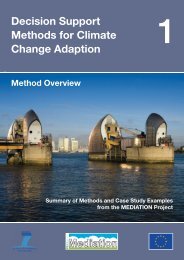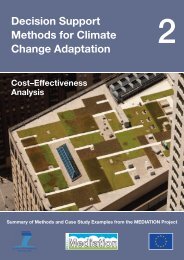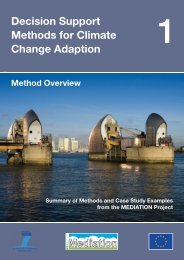Adaptation Turning Points - Mediation
Adaptation Turning Points - Mediation
Adaptation Turning Points - Mediation
You also want an ePaper? Increase the reach of your titles
YUMPU automatically turns print PDFs into web optimized ePapers that Google loves.
<strong>Adaptation</strong> <strong>Turning</strong> <strong>Points</strong>Case Study 2: <strong>Turning</strong> points for wine production in Tuscany, ItalySocial-political thresholds of interestThis case study explores wine production in Tuscany, Italy under climate change. Wine production inthe region is progressively changing from mixed farming system to specialized viticulture. Part of thischange is the rediscovery and improvement of traditional and autochthonous vines and a switch toquality production with lower yields, less chemicals and increased value of produced wine. Thenumber of vine-growing farms has been reduced by half over the last 20 years, while average farmsize has increased. Significantly, more than half of the total regional vineyard surface is labelled asDesignation of Origin (DO).The associations and unions in the region offer incentives in support of the above mentionedspecialisation. Regione Toscana encourages the renewal of old vineyards, on the basis of farmersapplication and selection. Associations also create awareness that agriculture has created a uniquelandscape in Tuscany that is both productive and internationally recognised for its beauty. The imageof the vineyard, surrounded by the classic, quiet and clean Tuscan landscape, offers a competitiveadvantage for the wine that is produced there. Thus, agriculture has both an economic, andenvironmental and landscape value in Tuscany. At the same time the strict landscape conservationand production rules can limit adaptation.Farmers in Tuscany already observe consequences of climate change and express an increasinginterest in adaptation. A key question is whether climate change will make farmers change grapevarieties, move to other locations or switch to other livelihoods. Here it is feared that changes inviniculture could have detrimental effects on the landscape, and therefore on tourism and quality ofliving. After stakeholder consultation the main questions and thresholds of interest are:• (when) does wine production in its current form become unviable in the region?• (when) does adaptation become attractive?Farmers expressed an immediate interest in two adaption strategies: moving production to higherelevations and changing to new varieties. These adaptive actions have a response time of at least 4-10years (the time it takes for a new wine yard to become productive). Farmers and government representativesstress the crucial importance of assessing wine quality, rather than the more typically modelledproduction quantity, as the survival of Tuscan viticulture is strictly linked to its high-quality wines.Climatic conditions for reaching thresholdsFarmers already observe a strong relationship between an increase in temperature and the reduction ofthe vegetative cycle of the vine. The grapes are ripening earlier compared to twenty years ago, withconsequent advance of harvest operations. Literature finds improvement of wine quality with risingtemperature at first, yet falling beyond a certain threshold, depending on variety. This corresponds witha shift in the area best suitable for grapevine cultivation either to higher elevations or to higher latitudes.<strong>Adaptation</strong> turning points and lessonsA farmer reaches an adaptation turning point the moment that wine quality drops below a desiredquality or wine of a higher quality can be produced at a higher elevation. To assess whether andwhen this may happen the study used a modelling framework for investigating climate changeimpacts on viticulture in the Tuscany region (Moriondo et al., 2011). Downscaled climate data(temperature, precipitation and CO 2level from observations and the IPCC SRES scenarios A2 andB2 from different climate models) are input to a vintage quality model for climate change impactassessment. The vintage quality model uses a multi-regressive approach and vintage ratingsobtained from the most recently published Sotheby’s vintage ratings. The ratings are on a scale from0 to 100, with the general categories of 0–39 disastrous, 40–59 very bad, 60–69 disappointing, 70–79average to good, 80–89 good to very good, 90–100 excellent to superb.7





